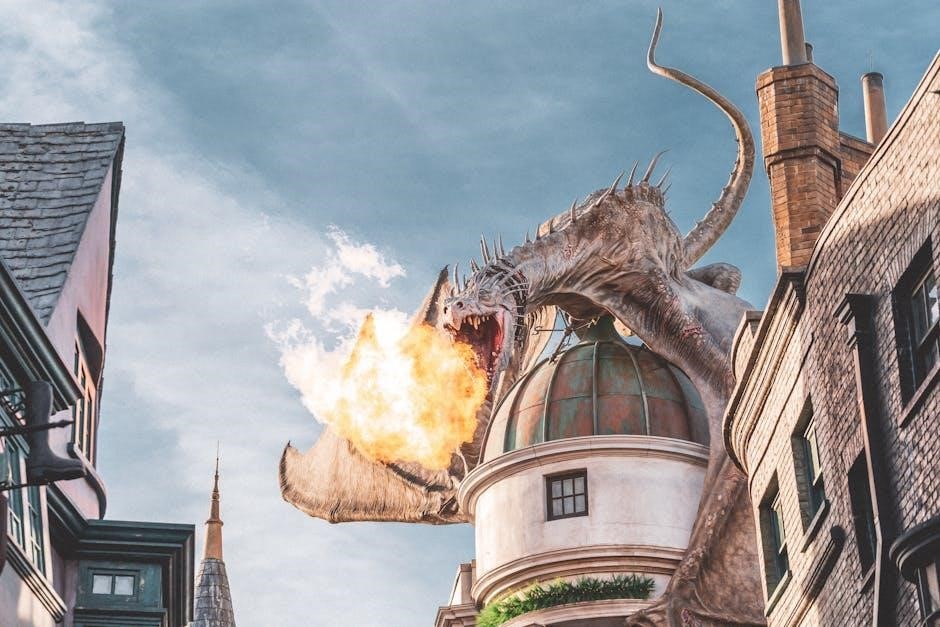Harry Potter and the Order of the Phoenix follows Harry’s fifth year at Hogwarts, marked by the Ministry’s denial of Voldemort’s return and the rise of Dumbledore’s Army. This book explores Harry’s emotional struggles, the formation of a secret group to counter dark forces, and the escalating battle between good and evil in the wizarding world.
Overview of the Book’s Significance
Harry Potter and the Order of the Phoenix is a pivotal installment in the series, marking Harry’s transition from childhood to adolescence. The book explores themes of rebellion, denial, and the complexities of leadership. It highlights the wizarding world’s refusal to acknowledge Voldemort’s return, creating tension and isolation for Harry. The novel also delves into Harry’s emotional struggles, making it a deeply character-driven story. Its significance lies in its dark tone, which reflects the growing stakes of the series, and its role in setting the stage for the events of the subsequent books. It remains a fan favorite for its raw emotion and thematic depth.
Setting: Harry’s Fifth Year at Hogwarts

Harry’s fifth year at Hogwarts is marked by tension and upheaval. The Ministry of Magic’s denial of Voldemort’s return creates a strained atmosphere, with Dolores Umbridge, a Ministry-appointed teacher, enforcing oppressive policies. Hogwarts, once a sanctuary, becomes a place of conflict as Umbridge restricts defensive magic training. The castle’s hidden passages and secrets, like the Room of Requirement, play a crucial role in the story. Meanwhile, the wizarding world’s division between believers and skeptics of Voldemort’s return isolates Harry, heightening his emotional struggles. This setting underscores the growing darkness and the challenges Harry faces during this pivotal year.
The Ministry of Magic’s Denial of Voldemort’s Return
The Ministry of Magic’s refusal to acknowledge Voldemort’s return dominates the story. Fearing panic and instability, the Ministry launches a smear campaign against Harry and Dumbledore, portraying them as liars. This denial leads to the appointment of Dolores Umbridge, a Ministry loyalist, as Hogwarts’ High Inquisitor. Umbridge’s oppressive regime at the school stifles dissent and prevents the teaching of practical defensive magic, leaving students unprepared for the rising threat. The Ministry’s actions create a climate of distrust and isolation, further alienating Harry and exacerbating his emotional turmoil. This denial underscores the theme of governmental corruption and the dangers of ignoring truth.

The Formation of Dumbledore’s Army

Dumbledore’s Army forms as a secret group of students learning defensive magic, led by Harry. This club counters Umbridge’s restrictions and prepares members for real threats, fostering unity and skill among its participants.
The Purpose of the DA
The Dumbledore’s Army (DA) was formed to counter the Ministry’s interference and Dolores Umbridge’s ineffective teaching of defensive magic. Harry, recognizing the need for practical skills, secretly trained students in spells to protect against dark forces. The DA became a vital resistance group, fostering unity and preparedness among its members. It aimed to empower students to defend themselves and others against the growing threat of Voldemort’s followers. Through secret meetings in the Room of Requirement, the DA focused on mastering defensive techniques, ensuring they were ready to face the darkness looming over the wizarding world.
Key Members and Their Roles
The DA’s core members included Harry, Hermione, and Ron, who led the group and organized sessions. Neville Longbottom played a crucial role in discovering the Room of Requirement, while Ginny Weasley demonstrated exceptional magical skill. Luna Lovegood brought loyalty and an unconventional perspective, and Fred and George Weasley contributed their inventiveness. Other members like Seamus Finnigan, Dean Thomas, and Neville’s growth in confidence were pivotal. Together, they formed a united front, leveraging their unique strengths to challenge the Ministry’s denial and prepare for the looming darkness. Each member’s dedication and courage were essential to the DA’s success and impact on the wizarding world.
The Discovery of the Room of Requirement
The Room of Requirement, a hidden space within Hogwarts, was discovered by Neville Longbottom during Harry’s fifth year. This magical room, also known as the Come and Go Room, could only be revealed to those in genuine need. Its discovery was pivotal for the DA, as it provided a secret location for their meetings and training. The room’s ability to transform itself to meet the needs of its users made it an ideal sanctuary for the group. Neville’s role in finding it underscored his growing importance in the fight against darkness, and the room became a symbol of resourcefulness and unity for the DA.

Harry’s Emotional and Character Development
Harry faces intense emotional struggles, grappling with anger and trauma from Cedric’s death. Voldemort’s influence grows, but Harry also develops leadership skills, supported by loyal friends.
Harry’s Struggle with Anger and Trauma
Harry grapples with intense anger and trauma, exacerbated by Cedric’s death and Voldemort’s return. His emotional turmoil worsens as the Ministry denies Voldemort’s resurgence, isolating him further. The Dark Lord’s influence grows stronger, feeding on Harry’s negative emotions and creating a deeper connection between them. This internal conflict strains Harry’s relationships with friends and mentors, as his frustration often boils over. The book vividly portrays his struggles, highlighting how unresolved trauma can amplify vulnerability. Harry’s journey in this installment underscores the psychological toll of his experiences and his ongoing battle to maintain hope amidst darkness and despair.
The Influence of Voldemort’s Emotions on Harry
Voldemort’s emotions significantly impact Harry, as their psychological connection deepens. Harry experiences dark, intrusive thoughts and anger, reflecting Voldemort’s influence. This telepathic link exposes Harry to the Dark Lord’s hatred and arrogance, intensifying his internal turmoil. The connection becomes a double-edged sword: while it offers Harry glimpses of Voldemort’s plans, it also burdens him with the weight of the Dark Lord’s malevolence. This emotional invasion forces Harry to confront the blurred lines between his own identity and Voldemort’s, highlighting the profound impact of their bond and its role in the story’s progression.
Harry’s Growth in Leadership and Responsibility
During his fifth year, Harry evolves significantly as a leader, taking on greater responsibility. He forms Dumbledore’s Army to teach his peers defensive magic, showcasing his initiative and determination. Despite facing challenges and skepticism, Harry remains committed to preparing his fellow students. His leadership role helps him develop confidence and resilience, transforming him from a reactive hero to a proactive guide. This growth is crucial as Harry learns to trust himself and inspire others, laying the foundation for his future role in the fight against Voldemort and the protection of the wizarding world.

Major Themes in the Book
The novel explores rebellion, friendship, and the struggle between good and evil, highlighting Harry’s internal battles and the wizarding world’s resistance against oppressive forces.
The Theme of Rebellion and Resistance
The theme of rebellion and resistance is central to Harry Potter and the Order of the Phoenix, as Harry and his allies challenge the Ministry’s denial of Voldemort’s return. Forming Dumbledore’s Army, Harry leads a secret group of students to learn defensive magic, defying the oppressive regime of Dolores Umbridge. The discovery of the Room of Requirement symbolizes the power of rebellion, providing a hidden space for resistance. This theme underscores the importance of standing against authority when it fails to protect, highlighting the strength of collective action and the courage to challenge injustice, even in the face of overwhelming odds.
The Power of Friendship and Loyalty
The power of friendship and loyalty shines brightly in Harry Potter and the Order of the Phoenix, as Harry, Ron, and Hermione stand together against overwhelming challenges. Their bond strengthens as they face the Ministry’s denial, Dolores Umbridge’s tyranny, and Voldemort’s growing threat. The loyalty of friends like Ginny, Luna, and Neville provides Harry with unwavering support, while the formation of Dumbledore’s Army highlights the unity and commitment of students willing to fight for what is right. Through shared struggles and victories, their friendships inspire hope and resilience, proving that loyalty and trust are powerful forces against darkness and adversity.
The Struggle Between Good and Evil
In Harry Potter and the Order of the Phoenix, the struggle between good and evil intensifies as Voldemort’s power grows. Harry, as “The Chosen One,” embodies the fight against darkness, while Voldemort represents pure malevolence. The Ministry’s denial of Voldemort’s return deepens the conflict, creating internal strife within the wizarding world. The Battle of the Department of Mysteries and the Prophecy’s revelation highlight the clash between light and darkness. Moral complexities arise, such as the temptation of power and the blurred lines between right and wrong. Ultimately, the novel underscores that the struggle between good and evil is defined by choices, courage, and the enduring fight for justice.

The Role of the Order of the Phoenix
Harry Potter and the Order of the Phoenix highlights the Order’s mission to counter Voldemort’s rise. This secret group, led by Dumbledore, protects Harry and combats dark forces, ensuring the wizarding world’s safety and justice.
Who Are the Members of the Order?
The Order of the Phoenix comprises a diverse group of wizards and witches united against Voldemort. Key members include Albus Dumbledore, the founder, Minerva McGonagall, Remus Lupin, Sirius Black, and Severus Snape, each bringing unique skills to the fight. Other notable figures like Nymphadora Tonks, Kingsley Shacklebolt, and Alastor Moody contribute to the Order’s strength. Together, they form a formidable alliance dedicated to protecting Harry and combating the Dark Lord’s followers, ensuring the wizarding world’s safety during its darkest hour.
Their Mission to Counter Voldemort
The Order of the Phoenix is dedicated to thwarting Voldemort’s resurgence by gathering intelligence, disrupting Death Eater activities, and protecting key targets. Their mission involves safeguarding Harry, who is crucial to the fight against the Dark Lord. Members engage in covert operations, counter dark magic, and prepare the wizarding community for potential conflicts. By uniting against a common threat, the Order aims to weaken Voldemort’s power and ultimately defeat him, ensuring the wizarding world’s safety and freedom from tyranny.
The Battle at the Department of Mysteries
The Battle at the Department of Mysteries is a climactic confrontation between the Order of the Phoenix and Voldemort’s Death Eaters. Harry, alongside Ron, Hermione, Neville, and Luna, faces off against the Dark Lord’s followers in a desperate bid to protect a prophetic vision. The battle is intense, with spells and chaos erupting throughout the Ministry’s mysterious halls. Tragically, Sirius Black falls during the fight, leaving Harry devastated. The arrival of Dumbledore and other Order members turns the tide, but the loss of Sirius underscores the war’s escalating stakes and the emotional toll on Harry.

The Horcrux Mystery and Its Significance
The Horcrux mystery reveals Voldemort’s secret to immortality through fragmented souls. Harry’s first glimpse into this darkness connects him to Voldemort, deepening the story’s complexity and stakes.
Harry’s First Glimpse of the Horcruxes
During his fifth year, Harry first learns about Horcruxes through Dumbledore. These objects, containing fragments of Voldemort’s soul, are key to his immortality. Harry’s connection to Voldemort allows glimpses into the Dark Lord’s past, revealing the creation of these dark artifacts. The discovery shocks Harry, as it clarifies the true extent of Voldemort’s evil and the challenge of destroying him. This revelation marks Harry’s deeper understanding of his destiny and the burden he must carry to ultimately defeat Voldemort.
The Connection Between Harry and Voldemort
Harry’s unique bond with Voldemort stems from the piece of soul Voldemort unintentionally left within him during his attempted murder. This connection grants Harry glimpses into Voldemort’s thoughts and emotions, making him a crucial link to understanding the Dark Lord’s intentions. Throughout the story, Harry experiences increasing emotional turmoil as Voldemort’s influence grows stronger, particularly through negative emotions like anger and fear. This connection not only burdens Harry but also serves as a key element in the ultimate battle between good and evil, as it allows Harry to anticipate Voldemort’s actions and prepares him for their inevitable confrontation.
The Importance of Destroying the Horcruxes
The destruction of Horcruxes is vital as they are the key to Voldemort’s immortality. Each Horcrux contains a fragment of his soul, ensuring his survival even if his physical body is destroyed. By identifying and annihilating these hidden objects, Harry and his allies weaken Voldemort’s power, ultimately leading to his downfall. The process is perilous, requiring immense courage and sacrifice, but it is the only way to ensure Voldemort’s permanent defeat and restore peace to the wizarding world. This mission underscores the central theme of the series: the struggle between good and evil, with the Horcruxes as the focal point of the final battle.

Reception and Legacy of the Book
Harry Potter and the Order of the Phoenix was immensely popular and received critical acclaim, deepening the series’ themes and leaving a lasting legacy that shaped the future of the wizarding world.
Popularity and Critical Acclaim
Harry Potter and the Order of the Phoenix became an instant bestseller, captivating readers worldwide. Critics praised its darker tone, complex character development, and deeper exploration of themes like rebellion and trauma. The book solidified the series’ legacy, with many hailing it as a turning point in Harry’s journey. Its success was unmatched, selling millions of copies and earning widespread acclaim for its emotional depth and narrative brilliance. Fans and reviewers alike celebrated its ability to balance magic with real-world struggles, further cementing its place as a cornerstone of the Harry Potter saga.
Impact on the Harry Potter Series
Harry Potter and the Order of the Phoenix significantly shaped the series’ trajectory. It introduced the Horcrux mystery, a pivotal plot point, and deepened the connection between Harry and Voldemort. The book’s darker themes and character development set the tone for the subsequent novels, preparing readers for the impending war. By exploring Harry’s emotional turmoil, the story added layers to his character, making his eventual rise as a leader more compelling. This installment is often regarded as a fan favorite, marking a maturation in storytelling that resonated deeply with audiences, ensuring its lasting influence on the series’ overarching narrative.
Adaptations and Cultural Influence

Harry Potter and the Order of the Phoenix was adapted into a successful film in 2007, directed by David Yates, starring Daniel Radcliffe, Emma Watson, and Rupert Grint. The movie captured the book’s darker tone, receiving widespread acclaim for its visual storytelling and emotional depth. The story also inspired video games, further immersing fans in the magical world. Culturally, the book and its adaptations sparked fan art, fan fiction, and widespread discussions. Its themes of resistance and unity resonated globally, making it a cornerstone of pop culture and inspiring a generation to embrace the fight against oppression, both within the wizarding world and beyond.

Leave a Reply